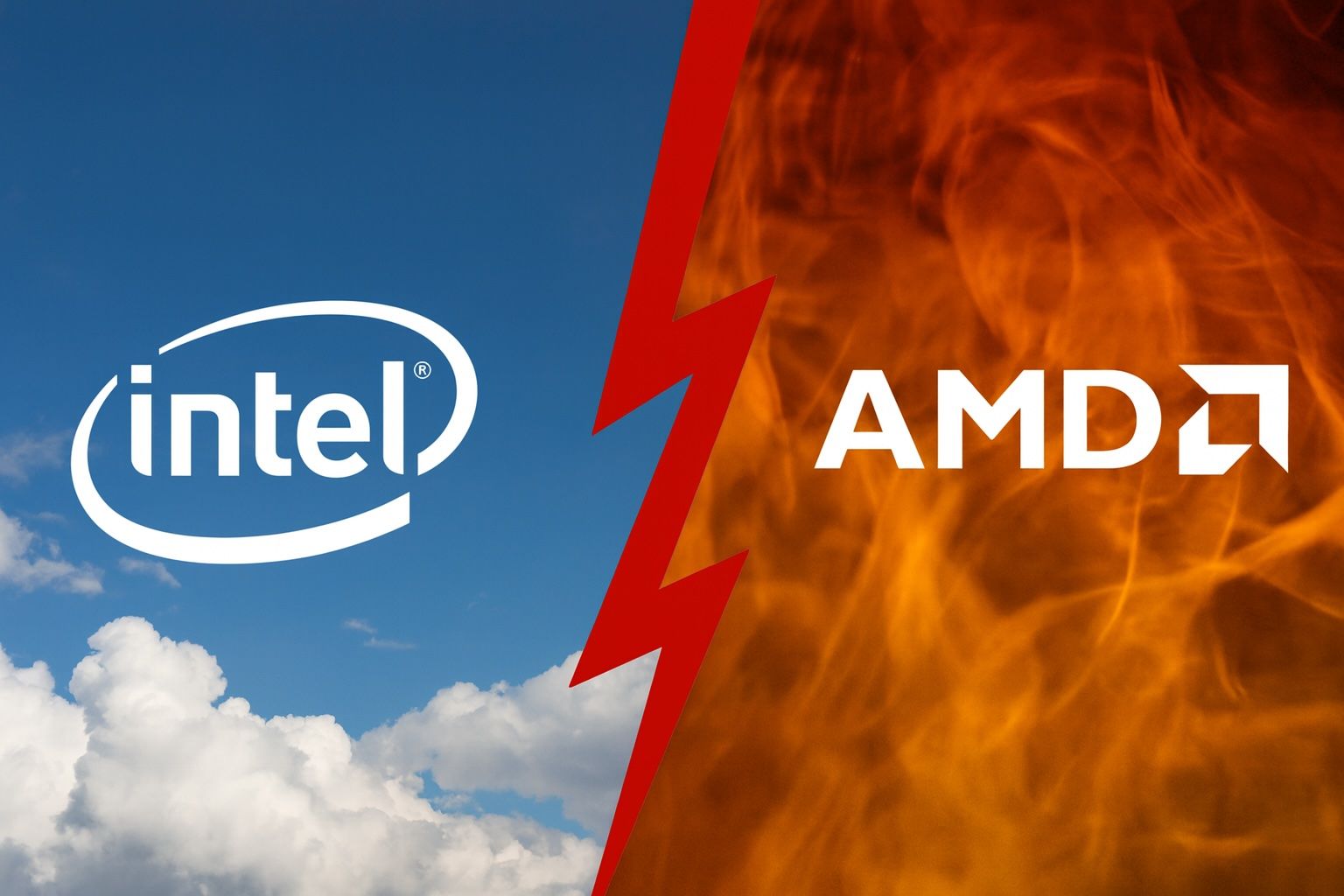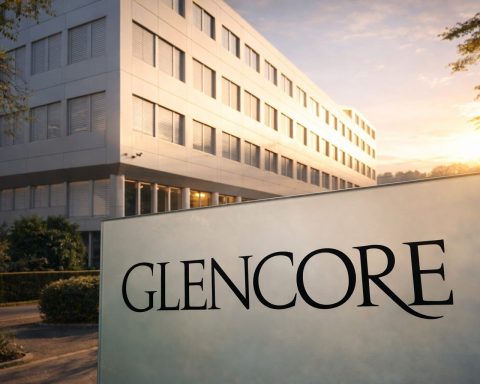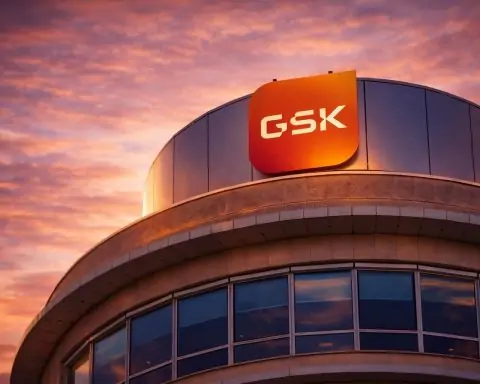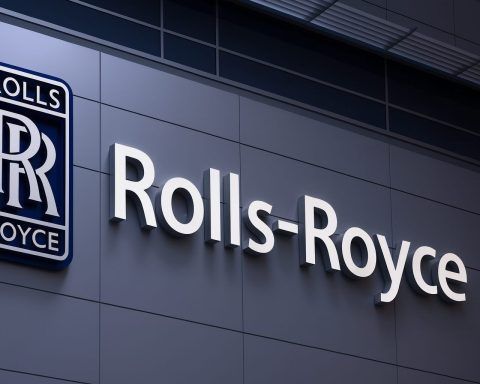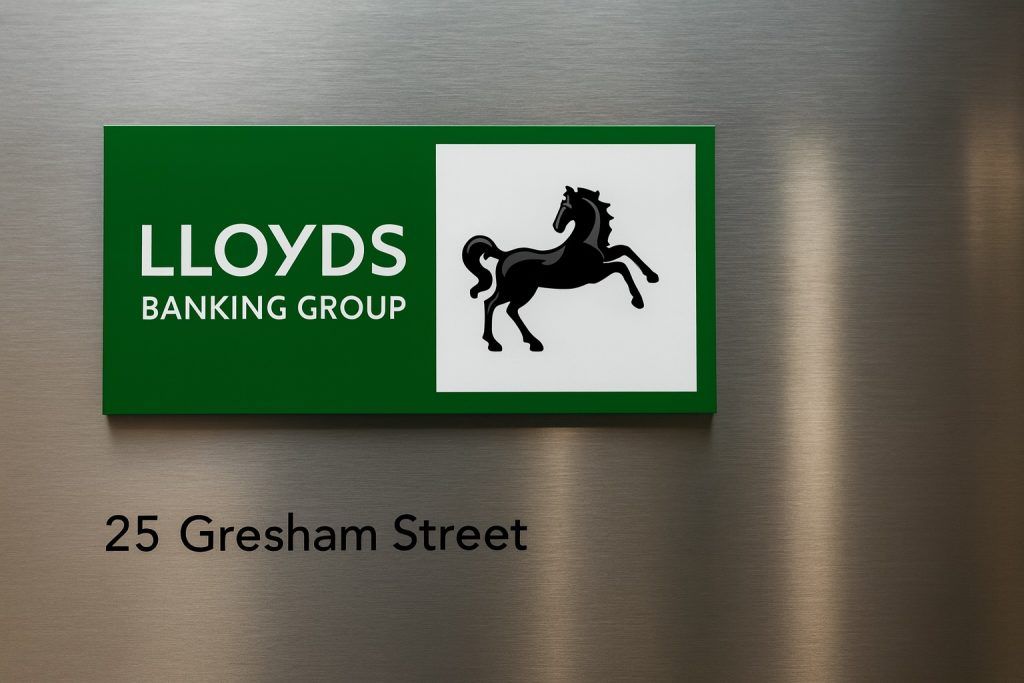- Stock Surge: Intel shares hit about $38 on Oct. 23, 2025 (near a 52-week high) and are up roughly 85% in 2025 [1] [2]. AMD stock trades near $235, up about 80% year-to-date [3] [4].
- Market Value: Intel’s market capitalization is roughly $178 billion, versus about $380 billion for AMD [5] [6] (Intel’s is roughly half AMD’s [7]).
- Revenue & Profit: Intel lost $18.8 billion in 2024 (its first annual loss since 1986) [8]. AMD is profitable – it expects about $32.8 billion in 2025 revenue [9]. In Q3 2025, Intel beat estimates with $13.7 B revenue and $0.23 EPS (vs. $0.02 expected) [10], while in Q2 AMD reported $7.69 B revenue and $0.48 EPS [11] (its profit jumped ~229% year-on-year [12]).
- P/E Ratios: Intel’s trailing P/E is negative (due to losses), and its forward P/E is extremely high (~310) [13], reflecting thin profits. (AMD’s trailing P/E is currently very elevated as well, given its strong recent profit growth – analysts cite values well above 50.)
- AI Deals & Innovation: Both companies are in the AI arms race. AMD just won massive contracts with OpenAI (supplying ~6 gigawatts of GPUs) and Oracle Cloud (50,000 new GPUs), sparking one-day gains of 34% and 3% respectively [14]. Intel secured a ~$10 billion U.S. government stake (via CHIPS Act funds) and billions from Nvidia and SoftBank [15] [16], fueling its rally. AMD rolled out new AI hardware (Instinct GPUs, Helios racks, Threadripper CPUs) [17] while Intel is cutting costs and eyeing new foundry deals [18] [19].
- Analyst Sentiment: Wall Street is cautious on Intel – most firms rate INTC a “Hold/Reduce.” MarketBeat notes Intel’s consensus rating is “Reduce” with a $29 price target (far below today’s ~$38) [20] [21]. By contrast, analysts have turned very bullish on AMD: over a dozen firms lifted AMD’s 12-month price targets into the $250–$300 range (HSBC at $310, Jefferies/Wolfe at $300) [22], and roughly 60–65% of analysts now rate AMD a “Buy” [23].
Stock Prices & Recent Trends
Intel’s Santa Clara headquarters at sunset (Intel logo on campus). Intel stock has doubled off its mid-2025 lows, recently hitting intraday highs around $39.65 [24] [25]. An 85% rally YTD makes INTC one of the market’s top performers [26]. Investor enthusiasm is fueled by headlines – in late August Washington converted CHIPS Act grants into a ~10% equity stake in Intel ($10B), while tech heavyweights Nvidia and SoftBank invested $5B and $2B respectively [27] [28]. These blockbuster deals, plus rumors of new foundry partnerships, have helped push Intel to its highest price in years. However, analysts warn the fundamentals lag the hype: Intel only recently returned to quarterly profitability, and many note the stock has “climbed too far, too fast” without sustained earnings recovery [29] [30].
AMD’s rally is even wilder. AMD shares have surged on AI megadeals. A 34% one-day jump on Oct. 6 was triggered by news of a multi-year OpenAI GPU supply pact worth “tens of billions” [31]. A week later, Oracle’s cloud unit said it will deploy tens of thousands of AMD GPUs in new AI superclusters [32]. These catalysts helped lift AMD stock to all-time highs near $240 [33]. By Oct. 23, AMD settled around $234.99 (about 3% up on the day) [34]. Despite recent volatility (shares slipped a few percent after these runs [35]), AMD remains ~80% above its Jan 2025 price [36], far outpacing the Nasdaq overall. Industry veterans note this surge reflects broad excitement about AMD’s growing role in data-center AI, even though Nvidia still dominates the market [37] [38].
Market Cap, Revenue & Profit
Intel’s market value is roughly $178 billion (about 4.67 billion shares × ~$38) [39]. AMD’s market cap is nearly twice as large – around $376–380 billion (roughly 1.62–1.63 B shares × $233–$235) [40]. (Ts2.tech notes Intel’s ~$175B value is “roughly half of AMD’s” [41].) For perspective, Nvidia’s market cap recently topped $1 trillion [42].
On sales, Intel is much bigger: 2024 revenue was ~$54B, but it spent aggressively on fabs and lost $18.8B [43]. AMD’s 2024 sales were about ~$30B, with 2025 revenue expected around $32.8B [44]. For Q3 2025, Intel reported $13.7B revenue and $0.23 EPS [45]. AMD’s Q2 2025 results showed $7.69B revenue and $0.48 EPS [46], beating forecasts despite some market headwinds (e.g. China export curbs) [47]. AMD said demand for its data-center and PC chips remains strong. In fact, its Q2 profit was up over 200% year-on-year, driven by booming AI/data-center sales [48].
Intel’s valuation reflects its turnaround risk: its forward P/E ratio is roughly 310 [49], and it generated only a few cents of profit per share recently. Analysts have noted that even after cost cuts, Intel is “still losing money” on an annual basis [50]. AMD, by contrast, is profitable, so its P/E is far lower (trading around 100× trailing EPS as of Oct 2025), but still high by historical tech standards given investors’ growth expectations.
Recent Earnings and Guidance
Intel’s latest earnings (Q3 2025) delivered more upside than expected. The company swung to profit, posting $0.23 adj. EPS vs. a consensus of just $0.02 [51]. Revenue of $13.7B was up 3% year-over-year and slightly above estimates [52]. CFO David Zinsner hailed the quarter as evidence of “steady progress” on Intel’s turnaround [53]. He noted Intel has “strengthened our balance sheet” with fresh funding and expects chip demand to “outpace supply into 2026” [54]. Intel’s outlook was also upbeat: it guided Q4 revenue to $12.8–13.8B (above forecasts).
AMD’s most recent report was Q2 2025 (announced Aug. 2025). It showed strong revenue growth but flagged a near-term slowdown in China sales. AMD’s CEO Lisa Su said U.S. export curbs will cut about $1.5 B from 2025 revenue (mainly in Q2–Q3) [55]. Nonetheless, Q2 profit jumped to $0.48 vs. $0.15 a year ago [56], on 28% higher revenue ($7.69B). The beat was attributed to continued data-center demand and cost discipline. Su expects China-related weakness to pass, with new “MI350” AI chips ramping late 2025 to offset any Q3 softness [57]. (The MI350 series and next-gen EPYC processors are due in Q4.) Overall, analysts were impressed that AMD exceeded estimates, calling it a “major vote of confidence” in its AI capabilities [58].
AI Deals and Product News
Both chipmakers have been in an AI arms race. For Intel, the story is the influx of cash and partnerships. In Aug–Sept 2025, the U.S. government converted grant funds into a ~10% equity stake in Intel [59] [60]. Nvidia agreed to invest $5 billion for a ~4% stake [61] [62], and SoftBank put in $2 billion. These strategic infusions are meant to bolster Intel’s foundry ambition. Intel also cut costs sharply (eliminating ~20% of its workforce) and is rumored to be in talks with major cloud firms (e.g. Microsoft Azure) for contract chip manufacturing [63]. However, Intel has been trailing in cutting-edge AI chips; its recent efforts focus on 4nm/3nm CPUs and GPUs (Arc series) and automated fab expansions. New CEO Lip-Bu Tan is steering Intel toward profitability – Wall Street awaits proof that the latest “AI hype” deals can turn into real sales.
AMD’s narrative is dominated by transformative AI partnerships and new hardware. In early Oct 2025, AMD announced a multi-year deal to supply OpenAI with around 6 gigawatts of its Instinct AI GPUs [64]. Forrest Norrod, AMD EVP, called this pact “certainly transformative, not just for AMD, but for the dynamics of the industry” [65]. CFO Jean Hu said the OpenAI deal should “deliver tens of billions of dollars in revenue” and be “highly accretive” to earnings [66]. OpenAI’s Sam Altman added that using AMD chips will help the company “build enough AI infrastructure to meet [its] needs” [67]. Just days later, Oracle Cloud revealed it will deploy 50,000 of AMD’s upcoming MI450 GPUs in new AI supercomputer clusters [68]. Each announcement sent AMD shares higher (the OpenAI news alone added about $80 billion to AMD’s market cap [69]).
On the product side, AMD is rolling out AI-ready systems. At an October industry summit, AMD unveiled “Helios” rack-scale AI servers (with EPYC CPUs, MI300/MI450 GPUs) built to Meta’s new open standards [70]. Oracle said its future AI clusters will use these Helios racks. AMD is also updating its PC/GPU lineup (e.g. new Radeon RX 9060 XT GPUs, Threadripper 9000 CPUs) to keep gamers and creators engaged [71]. These hardware launches reinforce AMD’s long-term strategy: “Each 1 gigawatt of AI capacity could translate to ~$20 billion in AMD sales,” one analysis notes [72].
Analyst Outlook & Expert Commentary
Wall Street’s views diverge sharply between the two chipmakers. For Intel, many analysts remain skeptical. Only 2 out of 32 surveyed firms rate INTC “Buy,” and the consensus price target is about $29 – well below the current ~$38 share price [73] [74]. MarketBeat reports Intel’s consensus rating is a “Reduce” with $29.26 target [75]. Several large brokerage firms have it as Neutral/Hold; for example, HSBC has a $24 target (rated “Reduce”) and KeyBanc recently reiterated a $35 target [76]. Bank of America cautioned the stock has “climbed too far, too fast” without fundamental improvement [77]. In mid-October, Wedbush did raise its Intel target slightly ($19→$20) but still kept a neutral stance [78]. Overall, the average 12-month target is in the mid-$20s [79].
By contrast, AMD enjoys broad bullishness. After its AI contract wins, multiple analysts lifted AMD’s 12-month targets into the $250–$300 range [80]. HSBC even set a $310 target, and Jefferies/Wolfe a $300 target [81]. These upgrades come from formerly cautious firms; e.g. Morgan Stanley and Goldman – historically neutral on AMD – have recently turned positive after the orders [82]. As a result, about 60–65% of analysts rate AMD a “Buy” now, up from ~50% before the deals [83]. One market observer summarizes: AMD’s new AI partnerships are a “major vote of confidence” in its technology [84].
Financial experts also weigh in. Michael Schulman, CIO at Running Point Capital, notes Intel’s rally is driven by headline news and funding – “visible cost and gross margin progress, AI-PC buzz, and $15B of fresh strategic funding” – even as revenue remains flat [85]. In short, Intel’s gains may reflect investor sentiment more than immediate profits. Veteran strategist Leah Bennett points out that AMD is still far behind Nvidia in AI chips, so these big deals “help validate [AMD’s] technology” but won’t dethrone Nvidia easily [86]. Meanwhile, Ryan Detrick of Carson Group cautions investors to watch Intel’s data-center pivot closely: demand for AI servers “may be paying closer attention to [AMD’s and Intel’s] data center segment” as a growth driver [87].
Future Trends: Looking ahead, analysts say Intel needs sustained customer wins to justify its high valuation. Its guidance implies modest growth ahead, but many expect Q4 profit around $0.08/share on ~$13B sales [88]. For AMD, the question is scaling its AI business while China issues fade. With the new deals and Intel’s resurgence, the long-run picture is mixed. AMD bulls argue its momentum will continue as AI spending accelerates – one bull notes each gigawatt of AI capacity could mean $20B in AMD revenue [89]. Intel’s backers hope the government and partner bets pay off in new fab business.
In summary, Intel stock is riding a wave of optimism from funding and partnerships, but the balance sheet is still weak [90] [91]. AMD stock is riding the AI boom, with record-high contracts and robust earnings growth [92] [93]. Investors will be watching whether these trends continue into the next quarters: can Intel translate hype into profits, and can AMD keep delivering chips to power the AI revolution?
Sources: News and data from Reuters, Investopedia, ts2.tech (TechStock²) analyses, and market research firms [94] [95] [96] [97] [98], among others. All financial figures and expert comments are as reported in the cited sources.
References
1. ts2.tech, 2. www.reuters.com, 3. ts2.tech, 4. www.reuters.com, 5. www.reuters.com, 6. www.financecharts.com, 7. ts2.tech, 8. www.reuters.com, 9. www.reuters.com, 10. www.investopedia.com, 11. www.reuters.com, 12. ts2.tech, 13. www.reuters.com, 14. ts2.tech, 15. ts2.tech, 16. www.reuters.com, 17. ts2.tech, 18. ts2.tech, 19. www.reuters.com, 20. www.marketbeat.com, 21. www.marketbeat.com, 22. ts2.tech, 23. ts2.tech, 24. ts2.tech, 25. www.reuters.com, 26. ts2.tech, 27. www.reuters.com, 28. ts2.tech, 29. ts2.tech, 30. www.reuters.com, 31. ts2.tech, 32. ts2.tech, 33. ts2.tech, 34. www.reuters.com, 35. ts2.tech, 36. ts2.tech, 37. www.reuters.com, 38. ts2.tech, 39. www.reuters.com, 40. www.financecharts.com, 41. ts2.tech, 42. ts2.tech, 43. www.reuters.com, 44. www.reuters.com, 45. www.investopedia.com, 46. www.reuters.com, 47. www.reuters.com, 48. ts2.tech, 49. www.reuters.com, 50. ts2.tech, 51. www.investopedia.com, 52. www.investopedia.com, 53. www.investopedia.com, 54. www.investopedia.com, 55. www.reuters.com, 56. www.reuters.com, 57. www.reuters.com, 58. www.reuters.com, 59. www.reuters.com, 60. ts2.tech, 61. www.reuters.com, 62. ts2.tech, 63. ts2.tech, 64. ts2.tech, 65. www.reuters.com, 66. ts2.tech, 67. ts2.tech, 68. ts2.tech, 69. ts2.tech, 70. ts2.tech, 71. ts2.tech, 72. ts2.tech, 73. www.marketbeat.com, 74. www.marketbeat.com, 75. www.marketbeat.com, 76. www.marketbeat.com, 77. ts2.tech, 78. www.marketbeat.com, 79. ts2.tech, 80. ts2.tech, 81. ts2.tech, 82. ts2.tech, 83. ts2.tech, 84. www.reuters.com, 85. www.reuters.com, 86. www.reuters.com, 87. www.reuters.com, 88. www.investopedia.com, 89. ts2.tech, 90. www.reuters.com, 91. ts2.tech, 92. ts2.tech, 93. ts2.tech, 94. www.reuters.com, 95. www.investopedia.com, 96. ts2.tech, 97. www.reuters.com, 98. www.marketbeat.com
